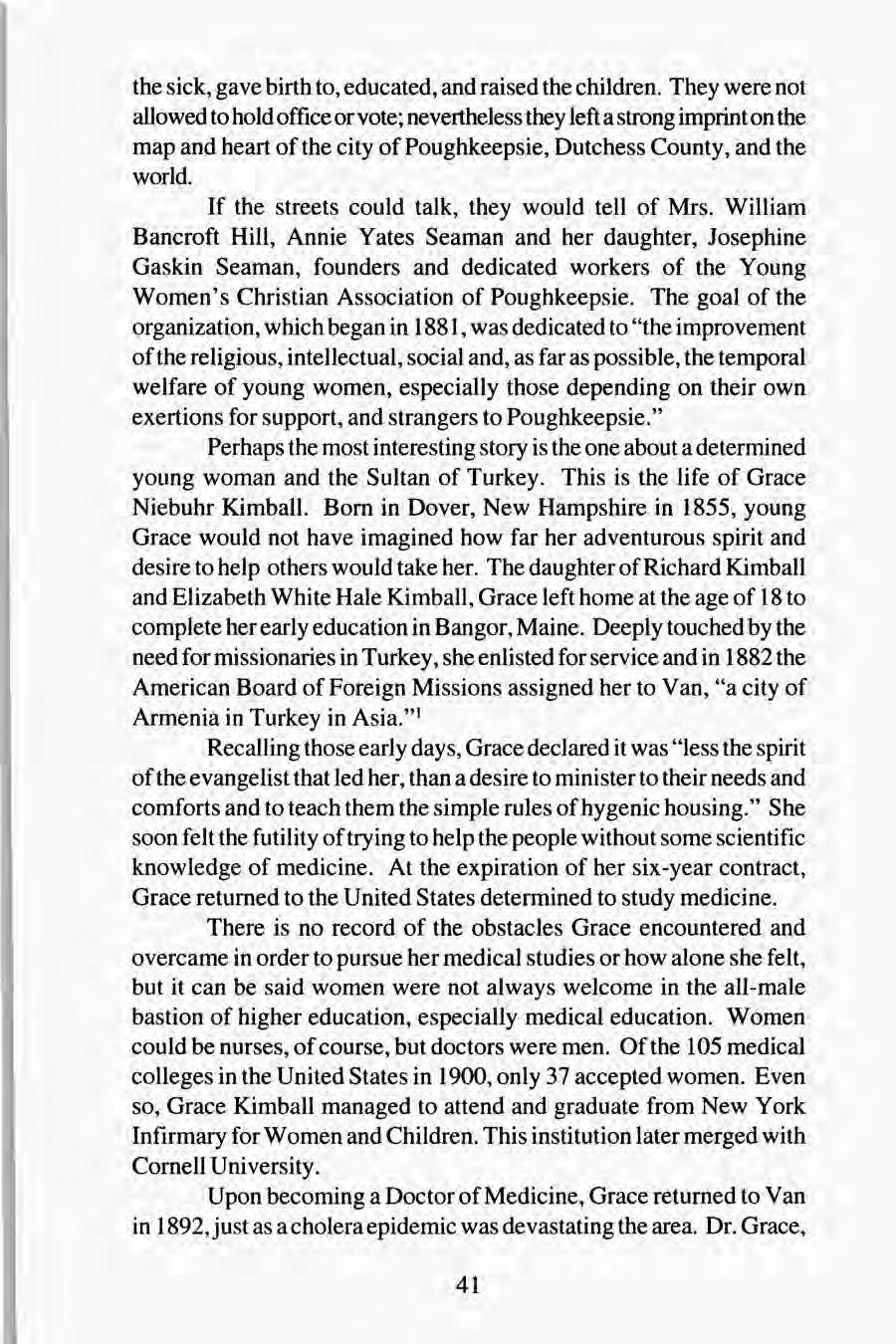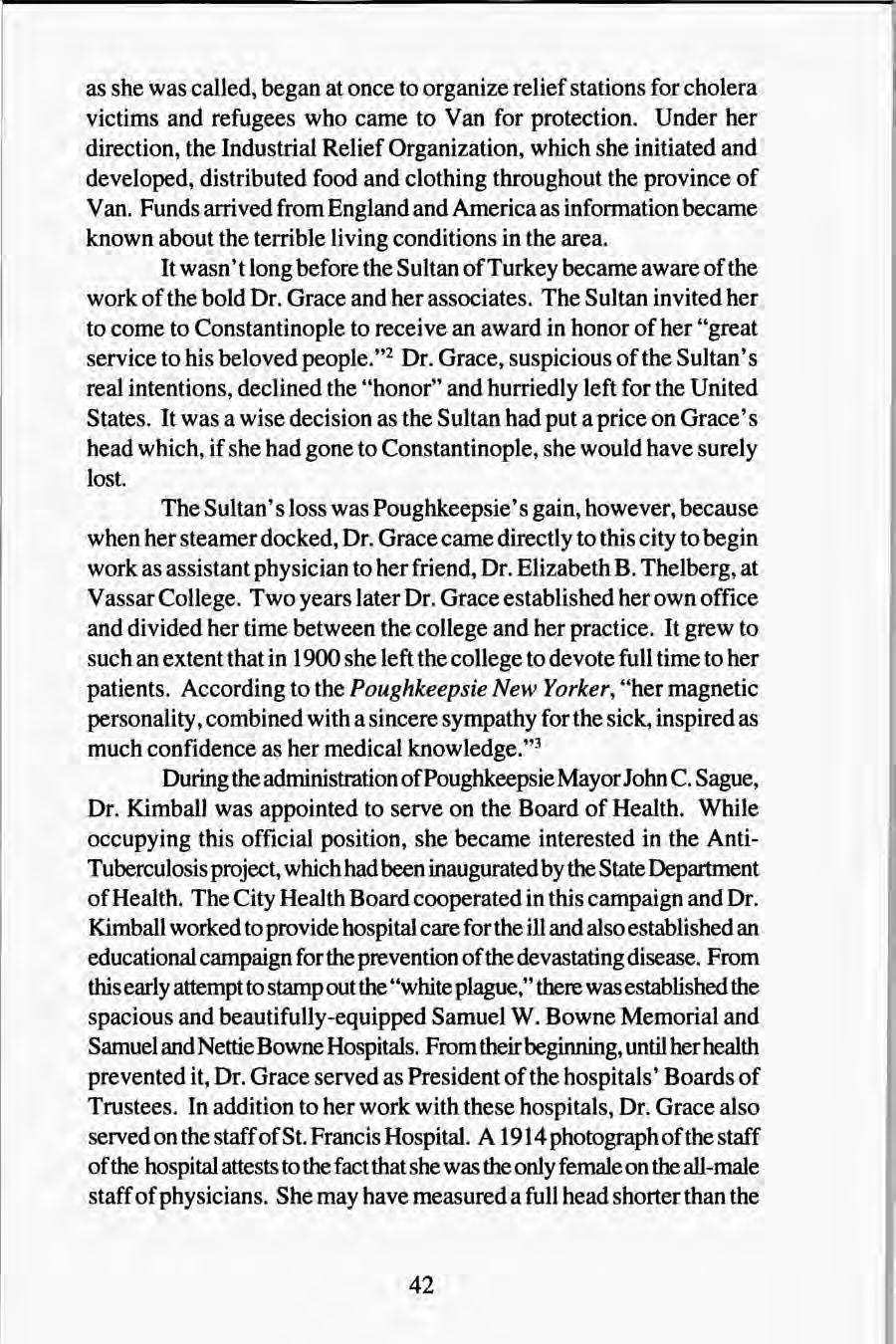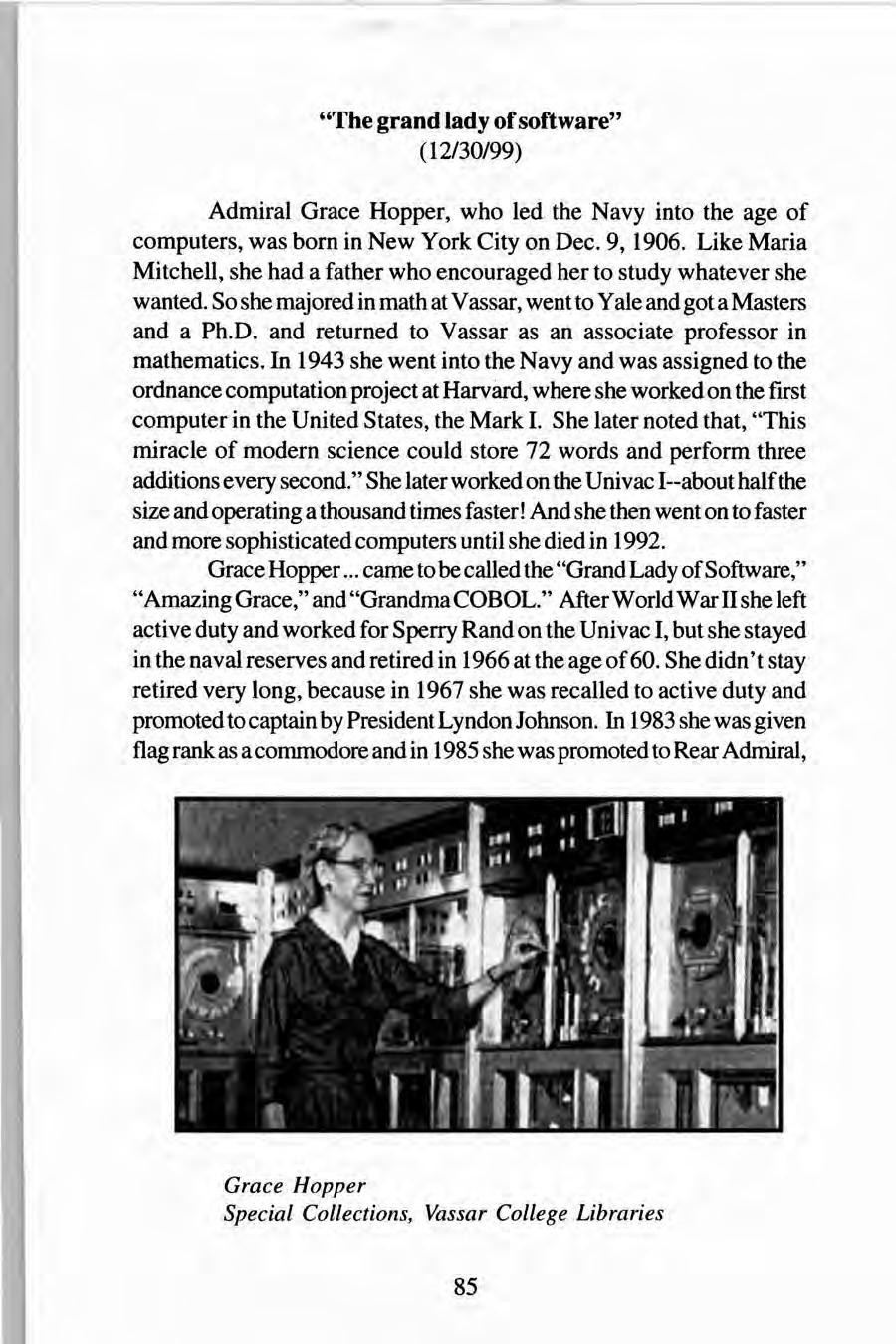
7 minute read
Walking with Grace
By Nancy Taubman
Nancy Taubman is a midwesterner who moved to Dutchess County in 1984. For the past seventeen years, until her retirement in 2001, she worked as public relations coordinator at the YWCA in Poughkeepsie. She.first became interested in Dr. Grace Kimball while working on a calendar for the 110th anniversary of the YWCA in 1991.
Dr. Grace N.Kimball
On the south side of Poughkeepsie there is a cluster of streets with pleasant homes and trees, tall and straight as soldiers. They mind their sentry duties well for they are keepers of the nearly forgotten stories of the women for whom these streets were named: Bancroft, Seaman, St. Anne, Yates, Gaskin, and Kimball. At the tum of the last century women worked in factories, offices and stores and, most importantly, at home. They tended
the sick, gave birth to, educated, and raised the children. They were not allowed to hold office or vote; nevertheless they left a strong imprint on the map and heart of the city of Poughkeepsie, Dutchess County, and the world.
If the streets could talk, they would tell of Mrs. William Bancroft Hill, Annie Yates Seaman and her daughter, Josephine Gaskin Seaman, founders and dedicated workers of the Young Women's Christian Association of Poughkeepsie. The goal of the organization, which began in 1881, was dedicated to "the improvement of the religious, intellectual, social and, as far as possible, the temporal welfare of young women, especially those depending on their own exertions for support, and strangers to Poughkeepsie." Perhaps the most interesting story is the one about a determined young woman and the Sultan of Turkey. This is the life of Grace Niebuhr Kimball. Born in Dover, New Hampshire in 1855, young Grace would not have imagined how far her adventurous spirit and desire to help others would take her. The daughter of Richard Kimball and Elizabeth White Hale Kimball, Grace left home at the age of 18 to complete her early education in Bangor, Maine. Deeply touched by the need for missionaries in Turkey, she enlisted for service and in 1882 the American Board of Foreign Missions assigned her to Van, "a city of Armenia in Turkey in Asia. " 1 Recalling those early days, Grace declared it was "less the spirit of the evangelist that led her, than a desire to minister to their needs and comforts and to teach them the simple rules ofhygenic housing." She soon felt the futility of trying to help the people without some scientific knowledge of medicine. At the expiration of her six-year contract, Grace returned to the United States determined to study medicine. There is no record of the obstacles Grace encountered and overcame in order to pursue her medical studies or how alone she felt, but it can be said women were not always welcome in the all-male bastion of higher education, especially medical education. Women could be nurses, of course, but doctors were men. Of the 105 medical colleges in the United States in 1900, only 37 accepted women. Even so, Grace Kimball managed to attend and graduate from New York Infirmary for Women and Children. This institution later merged with Cornell University. Upon becoming a Doctor of Medicine, Grace returned to Van in 1892, just as a cholera epidemic was devastating the area. Dr. Grace,

as she was called, began at once to organize relief stations for cholera victims and refugees who came to Van for protection. Under her direction, the Industrial Relief Organization, which she initiated and developed, distributed food and clothing throughout the province of Van. Funds arrived from England and America as information became known about the terrible living conditions in the area. It wasn't long before the Sultan of Turkey became aware of the work of the bold Dr. Grace and her associates. The Sultan invited her to come to Constantinople to receive an award in honor of her "great service to his beloved people."2 Dr. Grace, suspicious of the Sultan's real intentions, declined the "honor" and hurriedly left for the United States. It was a wise decision as the Sultan had put a price on Grace's head which, if she had gone to Constantinople, she would have surely lost.
The Sultan's loss was Poughkeepsie's gain, however, because when her steamer docked, Dr. Grace came directly to this city to begin work as assistant physician to her friend, Dr. Elizabeth B. Thelberg, at Vassar College. Two years later Dr. Grace established her own office and divided her time between the college and her practice. It grew to such an extent that in 1900 she left the college to devote full time to her patients. According to the Poughkeepsie New Yorker, "her magnetic personality, combined with a sincere sympathy for the sick, inspired as much confidence as her medical knowledge."3 During the administration of Poughkeepsie Mayor John C. Sague, Dr. Kimball was appointed to serve on the Board of Health. While occupying this official position, she became interested in the AntiTuberculosis project, which had been inaugurated by the State Department of Health. The City Health Board cooperated in this campaign and Dr. Kimball worked to provide hospital care for the ill and also established an educational campaign for the prevention of the devastating disease. From this early attempt to stamp out the "white plague," there was established the spacious and beautifully-equipped Samuel W. Bowne Memorial and Samuel and Nettie Bowne Hospitals. From their beginning, until her health prevented it, Dr. Grace served as President of the hospitals' Boards of Trustees. In addition to her work with these hospitals, Dr. Grace also served on the staff of St. Francis Hospital. A 1914 photograph of the staff of the hospital attests to the fact that she was the only female on the all-male staff of physicians. She may have measured a full head shorter than the

other doctors, but neither her height nor her gender kept Dr. Grace from additional service, which extended beyond the medical world to the community. In the early years of her residence in Poughkeepsie Dr. Grace was asked to serve on the board of the Young Women's Christian Association of Poughkeepsie. She was elected President in 1899, a position she held for 41 years. During her tenure, Dr. Grace was responsible for a great expansion of services and a broadening of the vision of the organization. The Poughkeepsie association became the first YWCA in the country to employ a secretary to direct "girls' work" --programs developed for young girls and teens. Through this program, young women were taught not only to embroider and sew, but to participate in archery, tennis, bow ling, roller skating, hiking and Bible Studies. Prompted by the needs of the first World War, girls and women were encouraged to become proficient in First Aid. Those who passed a test received a certificate signed by Woodrow Wilson. When Dr. Grace retired in 1940, YWCA activities were held in two buildings, the original three-story building on Cannon Street, and the "pool" building on Bancroft Road. With many additions and renovations, the Bancroft Road building continues to operate as the YWCA's main facility in Dutchess County. Recognized for her boundless energy and great ability, Dr. Grace was also appointed head of the Census. It was noted at her retirement party that, "this is the first time a woman has been recognized as competent to manage such important work." Another arena that received her attention was Woman's Suffrage. Dr. Grace became President of the National League of Women's Service in 1917. A favorite saying was "An ounce of 'start' is worth 2 pounds of 'think it over." Dr. Grace practiced what she preached. Blessed with a long life and professional success, Dr. Grace never forgot the suffering she had seen in Turkey. The first World War brought hardships to the doorsteps of Poughkeepsie. Dr. Grace also lived to see the approach of World War II. In her President's letter for the YWCA Annual Report, 1917-18, Dr. Grace wrote: "Let us each one be faithful wherever we are called to work, realizing that upon womanhood depends much of the success of the Nation .... " YWCA member Frances T. Rawson recalled in a talk she presented in 1981 that "before and during the war years the YWCA gym was filled with women practically every day rolling bandages for the Red Cross. Also

during the war, a large plot of ground at Cedarcliff was plowed up for Victory Gardens." In the YWCA Annual Report, 1916-17, Dr. Grace wrote: " ... our work stretches out to the suffering world." Despite her protests to the contrary, Dr. Grace had a deeply religious spirit. When she died on November 18, 1942, at the age of 87, her obituary stated: "Her creed was simple and her sympathies were broad. She expressed them both in love and service and for these outward tokens of her inward nature, she will long be remembered with affection and gratitude. "4
Endnotes
1 Poughkeepsie New Yorker, November 19, 1942, Obituary of Dr. Grace N.Kimball 2 Obituary of Dr. Grace N .Kimball 3 Obituary of Dr. Grace N.Kimball 4 Obituary of Dr. Grace N .Kimball











